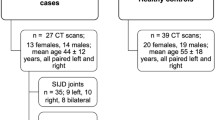Abstract
Purpose
To investigate if an association between spondylolisthesis and L5 fracture occurs in patients affected by Osteogenesis Imperfecta (O.I.).
Methods
Anteroposterior and lateral radiograms were performed on the sample (38 O.I. patients, of whom 19 presenting listhesis); on imaging studies spondylolisthesis was quantified according to the Meyerding classification. Genant’s semiquantitative classification was applied on lateral view to evaluate the L5 fractures; skeleton spinal morphometry (MXA) was carried out on the same images to collect quantitative data comparable and superimposable to Genant’s classification. The gathered information were analyzed through statistical tests (O.R., χ 2 test, Fisher’s test, Pearson’s correlation coefficient).
Results
The prevalence of L5 fractures is 73.7 % in O.I. patients with spondylolisthesis and their risk of experiencing such a fracture is twice than O.I. patients without listhesis (OR 2.04). Pearson’s χ 2 test demonstrates an association between L5 spondylolisthesis and L5 fracture, especially with moderate, posterior fractures (p = 0.017) and primarily in patients affected by type IV O.I.
Conclusions
Spondylolisthesis represents a risk factor for the development of more severe and biconcave/posterior type fractures of L5 in patients suffering from O.I., especially in type IV. This fits the hypothesis that the anterior sliding of the soma of L5 alters the dynamics of action of the load forces, localizing them on the central and posterior heights that become the focus of the stress due to movement of flexion–extension and twisting of the spine. As a result, there is greater probability of developing an important subsidence of the central and posterior walls of the soma.


Similar content being viewed by others
References
Smith R (1995) Osteogenesis Imperfecta: the brittle bone syndrome. Curr Orthop 9:28–33
Ivo R, Fuerderer S, Eysel P (2007) Spondylolisthesis caused by extreme pedicle elongation in osteogenesis imperfecta. Eur Spine J 16:1636–1640
D’Eufemia P, Finocchiaro R, Celli M, Zambrano A, Tetti M, Villani C, Persiani P, Mari E, Zicari A (2008) High levels of serum prostaglandin E2 in children with osteogenesis imperfecta are reduced by neridronate treatment. Pediatr Res 63(2):203–206
Sillence DO, Senn A, Danks DM (1979) Genetic heterogeneity in Osteogenesis Imperfecta. J Med Genet 16:101–116
Ward LM, Rauch F, Travers R (2002) Osteogenesis imperfecta type VII: an autosomal recessive form of brittle bone disease. Bone 31:12–18
Van Dijk FS, Pals G, Van Rijn RR, Nikkels PG, Cobben JM (2010) Classification of Osteogenesis Imperfecta revisited. Eur J Med Genet 53(1):1–5
Wang Z, Mac-Thiong JM, Parent S, Petit Y, Labelle H (2014) The relevance of sacral and sacro-pelvic morphology in developmental lumbosacral spondylolisthesis: are they equally important? Eur Spine J 23(1):157–162
Newman PH, Stone K (1963) The etiology of spondylolisthesis: with a special investigation. J Bone Joint Surg Br 45:39–59
Gutman G, Silvestre C, Roussouly P (2014) Sacral doming progression in developmental spondylolisthesis: a demonstrative case report with two different evolutions. Eur Spine J
Fürstenberg CH, Grieser T, Wiedenhöfer B, Gerner HJ, Putz CM (2010) The role of kyphoplasty in the management of osteogenesis imperfecta: risk or benefit? Eur Spine J 19(Suppl 2):S144–S148
Hatz D, Esposito PW, Schroeder B, Burke B, Lutz R, Hasley BP (2011) The incidence of spondylolysis and spondylolisthesis in children with osteogenesis imperfecta. J Pediatr Orthop 31:655–660
Meyerding HW (1932) Spondylolisthesis. Surg Gynecol Obstet 54:371–377
Genant HK, Wu CY, Van Kuijk C et al (1993) Vertebral fracture assessment using a semiquantitative technique. J Bone Miner Res 8:1137–1148
Hedlund LR, Gallagher JC (1988) Vertebral morphometry in diagnosis of spinal fractures. Bone miner 5:59–67
Mazzuoli GF, Diacinti D, Acca M et al (1998) Relationship between spine bone mineral density and vertebral body heights. Calcif Tissue Int 62:486–490
Genant HK, Jergas M, Palermo L et al (1996) Comparison of semiquantitative visual and quantitative morphometric assessment of prevalent and incident vertebral fractures in osteoporosis. J Bone Miner Res 11:984–996
Conflict of interest
None.
Author information
Authors and Affiliations
Corresponding author
Rights and permissions
About this article
Cite this article
Persiani, P., Graci, J., de Cristo, C. et al. Association between spondylolisthesis and L5 fracture in patients with Osteogenesis Imperfecta . Eur Spine J 26, 3106–3111 (2017). https://doi.org/10.1007/s00586-014-3737-5
Received:
Revised:
Accepted:
Published:
Issue Date:
DOI: https://doi.org/10.1007/s00586-014-3737-5




